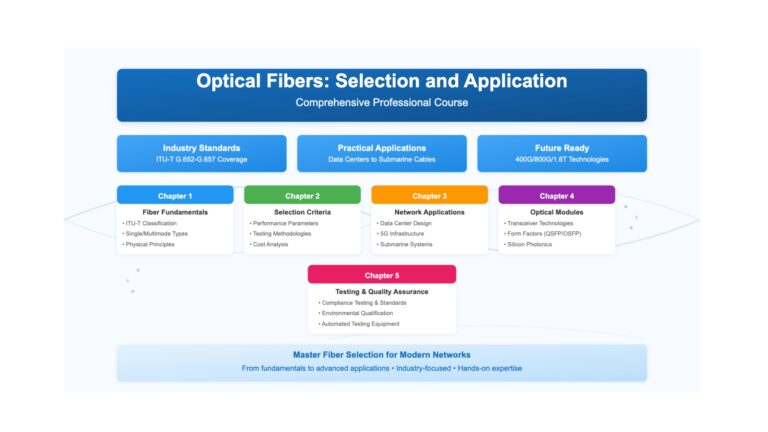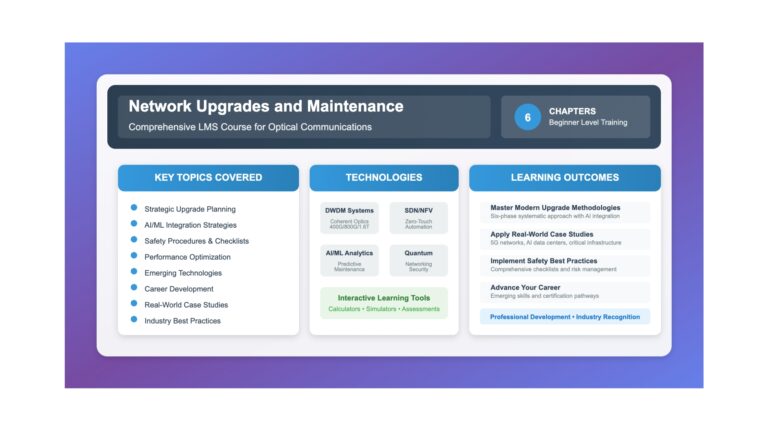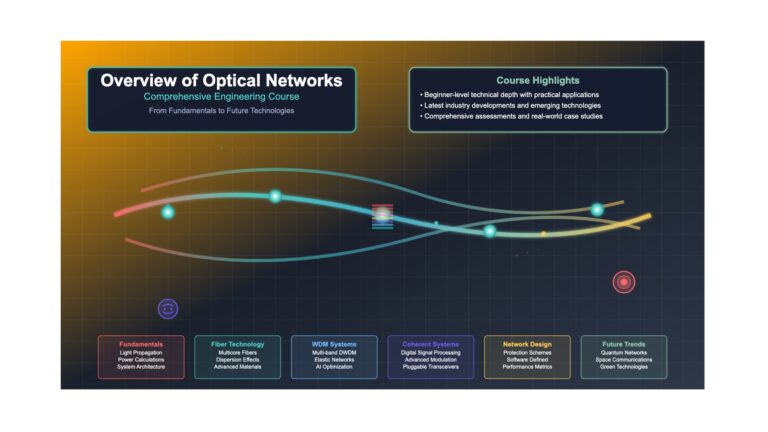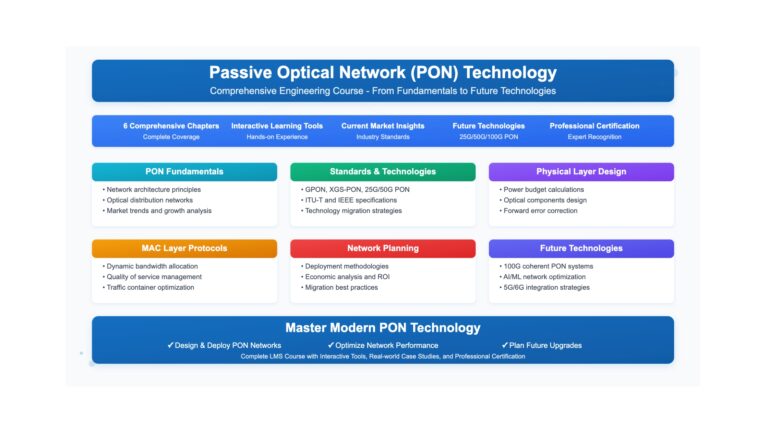Description
Curriculum
Instructor
Learning Objectives
- Understand the fundamental principles of Dense Wavelength Division Multiplexing (DWDM)
- Analyze the role and functionality of transponders in DWDM networks
- Compare different transponder types and their applications
- Evaluate transponder specifications for network design requirements
- Apply transponder selection criteria for various network scenarios
Curriculum
- 6 Sections
- 49 Lessons
- 10 Weeks
Expand all sectionsCollapse all sections
- Chapter 1: Introduction to DWDM and Transponders9
- 1.11. Introduction to DWDM Systems and Transponders
- 1.21.2 Evolution and Current State (2024-2025)
- 1.31.3 Understanding Transponders: The Heart of DWDM
- 1.41.4 Transponder Types and Categories
- 1.51.5 400ZR vs OpenZR+ Technology Comparison
- 1.61.6 Transponder Selection Criteria
- 1.71.7 Advanced Transponder Features
- 1.8Chapter Summary: Key Takeaways
- 1.9Knowledge Check: Chapter 1
- Chapter 2: Muxponders and Optical Transceivers7
- 2.12.1 Understanding Muxponders: Beyond Simple Transponders
- 2.22.2 Optical Transceivers: The Eyes of the Network
- 2.32.3 Digital Coherent Optics (DCO) Technology
- 2.42.4 Transceiver Selection Criteria and Best Practices
- 2.52.5 Future Trends and Emerging Technologies
- 2.6Chapter Summary: Key Takeaways
- 2.7Knowledge Check: Chapter 2
- Chapter 3: Multiplexers and ROADMs - The Backbone of DWDM9
- 3.13.1 Optical Multiplexers: Foundation of Wavelength Division
- 3.23.2 Reconfigurable Optical Add-Drop Multiplexers (ROADMs)
- 3.33.3 ROADM Loss Budget and Performance Analysis
- 3.43.4 Advanced ROADM Features and Capabilities
- 3.53.5 ROADM Selection Criteria and Network Design
- 3.63.6 Emerging Technologies and Future Trends
- 3.73.7 Troubleshooting and Maintenance
- 3.8Chapter Summary: Key Takeaways
- 3.9Knowledge Check: Chapter 3
- Chapter 4: Optical Fibers and Amplifiers - Signal Transmission and Boosting8
- 4.14.1 Optical Fiber Types for DWDM Networks
- 4.24.2 Fiber Impairments and Their Effects on DWDM
- 4.34.3 Optical Amplifiers: Boosting Signal Strength
- 4.44.4 Amplifier Placement and Network Design
- 4.54.5 Advanced Amplification Techniques
- 4.64.6 Fiber and Amplifier Integration
- 4.7Chapter Summary: Key Takeaways
- 4.8Knowledge Check: Chapter 4
- Chapter 5: Modulation Formats and Coherent Systems9
- 5.15.1 Evolution of Optical Modulation
- 5.25.2 Modulation Format Fundamentals
- 5.35.3 Polarization Multiplexing
- 5.45.4 Digital Signal Processing in Coherent Systems
- 5.55.5 Forward Error Correction (FEC)
- 5.65.6 Modulation Format Selection Criteria
- 5.75.7 Emerging Modulation Technologies
- 5.8Chapter Summary: Key Takeaways
- 5.9Knowledge Check: Chapter 5
- Chapter 6: Network Design Considerations and Dispersion Compensation7
Admin

29 Students36 Courses

Free
0 student
49 lessons
Language: English
0 quiz
Assessments: Yes
Skill level All levels
Courses you might be interested in
Fiber Optics & Components
Learning Objectives Understand the fundamental principles of optical fiber communication and light propagation Classify different types of optical fibers based on ITU-T standards and industry specifications Analyze the key physical...
-
41 Lessons
Free
Network Automation
Learning Objectives Understand the fundamental principles and drivers of network upgrades in modern optical communications Analyze capacity requirements, technology advancements, and cost-benefit considerations for upgrade decisions Evaluate compatibility, interoperability, and...
-
47 Lessons
Free
DWDM Technology
Learning Objectives Understand the fundamental principles of optical communication and light propagation Analyze the electromagnetic spectrum and optical window characteristics for fiber transmission Compare optical communication advantages over traditional electrical...
-
61 Lessons
Free
Advanced Technologies
Learning Objectives Understand the fundamental concepts and principles of Passive Optical Networks Analyze the evolution of optical access networks from copper to fiber technologies Compare PON architectures with traditional point-to-point...
-
36 Lessons
Free





